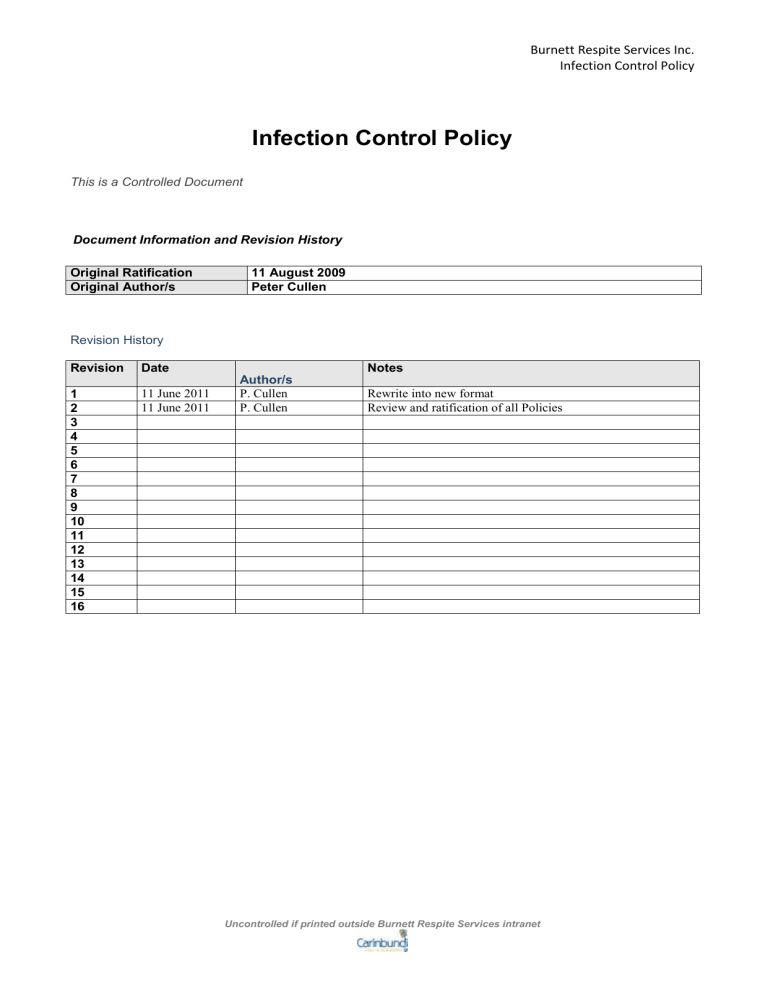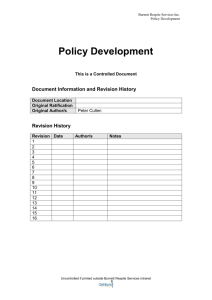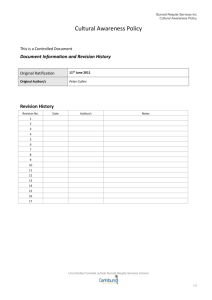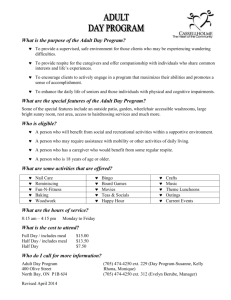Infection Control Policy

This is a Controlled Document
Infection Control Policy
Burnett Respite Services Inc.
Infection Control Policy
Document Information and Revision History
Original Ratification
Original Author/s
11 August 2009
Peter Cullen
9
10
11
12
13
14
15
16
5
6
7
8
1
2
3
4
Revision History
Revision Date
11 June 2011
11 June 2011
Author/s
P. Cullen
P. Cullen
Notes
Rewrite into new format
Review and ratification of all Policies
Uncontrolled if printed outside Burnett Respite Services intranet
Burnett Respite Services Inc.
Infection Control Policy
Infection Control Policy
1.0 Infection Control
1.1 Objectives
The objectives of this policy are: to provide a healthy environment in which all can grow and maintain a healthy lifestyle. The application of documented hygiene and infection control processes aims to prevent the spread of infections and will be followed by all people in the Service at all times.
1.2 Responsibilities
The Board of Management is responsible for:
monitoring and reviewing all organisational policies and procedures: and
auditing compliance with policy provisions, record keeping and training.
The General Manager is responsible for:
providing support and advice to staff; and
investigating and responding to issues arising from this policy..
All employees, paid and unpaid are responsible for:
adhering to all policies and procedures of the organisation; and
ensuring they are fully aware of and understand their obligations in relation to infection control.
In addition, the Workplace Health and Safety Officer is responsible for:
ensuring processes and protocols are in place to support all persons in maintaining an infection free environment.
1.3 Policy
At Burnett Respite Services Inc. we aim to create a safe and healthy work environment
The service promotes hygienic practices and prevents the spread of infections by implementing the following strategies:
effective handwashing; hygienic cleaning techniques;
safe handling, storage and disposal of body fluids;
maintenance of a hygienic environment;
updating knowledge of infectious diseases and exclusion guidelines;
identifying and excluding sick children and staff/carers; and
promoting and maintaining records of children’s and staff/carer’s immunisation.
Burnett Respite services Inc. has a duty of care to ensure that all persons are provided with a high level of protection during the service’s operation.
1.4 Further information
All employees who require further information are to read the Procedures and Guidelines following;
If any employee requires further information in relation to infection control they are to speak with the Workplace Health and Safety Officer or any member of the Management Team.
Uncontrolled if printed outside Burnett Respite Services intranet Page 1 of 11
Burnett Respite Services Inc.
Infection Control Policy
Procedures
It is essential to understand the way infection is controlled in any health care setting be it in a facility controlled by the organisation, an individual’s private home or other setting.
In the health care setting, in which this organisation operates, infection can easily spread from person to person.
A service user may be infected while receiving care.
A health worker may be infected while carrying out their duties.
People who work or interact with service users in a health care setting may be infected.
This transmission of infection is called cross infection.
. There is a two-tier approach to management of cross infection:
standard precautions, and
additional precautions.
Standard precautions
Standard precautions can be defined in three ways. They are:
safe work practices for the care and treatment of all service users regardless of their known or presumed infectious status,
the minimum required level of infection control in all settings and all situations, and
designed to protect both service users and our workers.
Standard precautions include the following five procedures:
hand washing,
use of personal protective equipment,
correct handling and disposal of waste,
appropriate cleaning of care equipment, and
hygienic environmental control.
Standard precautions apply whenever you may come in contact with the following four bodily substances:
blood (including dried blood),
all body substances, secretions and excretions (excluding sweat), regardless of whether or not they contain visible blood,
non-intact skin, and
mucous membranes.
Handwashing
Handwashing is the single most effective way to reduce the number of microorganisms on the surface of the skin. It should always be performed:
before and after contact with a service user,
before and after eating,
after using the toilet,
before and after using gloves,
after contact with used equipment, and
immediately following contact with bodily fluids.
Uncontrolled if printed outside Burnett Respite Services intranet Page 2 of 11
Burnett Respite Services Inc.
Infection Control Policy
Standard handwashing procedure:
1. Remove jewellery.
2. Wet hands thoroughly all over.
3. Use pH neutral soap.
4. Lather soap all over hands.
5. Rub hands together vigorously for 15-20 seconds. Pay particular attention to the fingertips, thumbs, wrists, finger webs and the backs of the hands.
6. Rinse under running water.
7. Pat hands dry with paper towels.
Barrier creams
The best protection against bacteria is intact skin, so each time you wash your hands you should apply barrier cream. Take care when cutting your finger nails and pay attention to maintaining intact cuticles. Any wound or abrasion should be covered using a waterproof dressing.
Waterless handwashing
There are waterless alcohol based hand wash solutions that are as effective as soap and water hand washing. These preparations should only be used when there is no visible soiling of the hands. If there is visible soiling, then soap and water hand washing should be used. These waterless preparations contain an emollient and aid in reducing damage to the hands.
Gloves do not replace hand washing; it is an additional protective measure to handwashing. Hands should be washed before and after using gloves.
Personal Protective Equipment (PPE)
Some of the duties that you perform in the workplace may require you to protect yourself from either the environment in which you are working, infectious service users, or to protect the service user from you if you are infectious.
Personal protective equipment also includes any substance, such as sunscreen, used to protect health.
Burnett Respite Services Inc. gives staff training in the relevant protective equipment necessary for their workplace. This training covers:
recognising the risk or hazard,
knowing when to use protective equipment,
basic understanding of the equipment and how it is protective,
selection of the correct equipment,
safe working practice when using equipment following the organisation ’s policies and procedures,
correct fit and comfort of PPE,
disposal/cleaning and storage of the goods,
limitations in use, and
replacement of equipment.
Yearly refresher courses should be held to ensure that all staff are up to date with the equipment. This regular education on the correct use of the equipment ensures that when staff need to use protective
Page 3 of 11 Uncontrolled if printed outside Burnett Respite Services intranet
Burnett Respite Services Inc.
Infection Control Policy equipment they fully understand how and when to use which equipment. All equipment for protective purposes must also meet with Australian standards.
Burnett Respite Services Inc. requires all employees to comply with correct personal protective equipment standards while at work.
Respiratory Protection
Masks are worn to protect you from the environment in which you are working, and infection from service users. They are also worn to protect the service user from you if you are infectious. The correct mask must be worn depending on the situation at hand.
Type of protective equipment
Type of use Correct usage Photo of the item in use
1. Paper Mask
Wear in areas where droplet infection of the service user is a concern.
Wear when the worker has a cold.
Cannot be worn for extended periods.
Cover the nose and mouth. Secure correctly behind your ears with elastic fastenings.
2. Surgical mask
Wear in areas where droplet infection of the service user is a concern.
Can be worn for extended periods.
Cover the nose and mouth. Secure correctly behind the ears with tape fastenings.
3. Specialised particulate respiratory filter mask
Wear to protect from droplet infection from active pulmonary tuberculosis service users.
Cover the nose and mouth. Secure correctly behind the ears with elastic fastenings.
Uncontrolled if printed outside Burnett Respite Services intranet Page 4 of 11
Burnett Respite Services Inc.
Infection Control Policy
4. Respiration mask
Wear when there are noxious fumes, harmful dusts, sprays, vapours and mists.
Has an inbuilt filtration system. Cover the nose and mouth. Secured correctly behind the ears by straps.
Foot Protection
Appropriate footwear should be worn at all times for your own safety and to prevent the spread of infection.
Type of protective equipment
Type of use Correct usage Photo of the item in use
1. Shoe covers
Wear to protect from contamination when entering an area of infection.
Wear to prevent contamination from spreading.
Cover shoe completely and tie securely. Made from polypropolene.
Discard after use.
2. Enclosed, waterproof footwear with non-slip soles
Wear at all times to reduce contact with blood, bodily secretions, excretions, disinfectants, chemicals.
Upper section of footwear should cover all of the upper foot and be made of waterproof material.
Soles should be made of a substance that reduces the chance of slipping.
Shoes should be flat, with a heel of not more than
2.5 cm.
Uncontrolled if printed outside Burnett Respite Services intranet Page 5 of 11
Burnett Respite Services Inc.
Infection Control Policy
3. Protective footwear
Wear to protect from splashes, drips, and the dropping or rolling of heavy objects.
Footwear with a steel toecap, a heavy duty upper and rubber soles.
Hand protection
Hand washing should be carried out before and after glove use as gloves may have pinholes or other defects. Workers who develop an allergy or sensitivity to glove powder or contact with latex proteins need to advise their supervisor that they require alternative gloves.
Type of protective equipment
Type of use Correct usage Photo of the item in use
1. Sterile gloves
Wear when likely to have contact with sterile body cavity or tissue of a client.
Always check for holes.
Only wear once. Discard after use.
2. Non sterile gloves
Wear to reduce contact with blood, bodily secretions, excretions, disinfectants, chemicals.
Always check for holes.
Only wear once. Discard after use.
3. General-purpose utility gloves
Wear for cleaning and during manual decontamination of used instruments and equipment
Always check for holes.
Clean and store dry between uses. Replace when showing signs of deterioration.
Uncontrolled if printed outside Burnett Respite Services intranet Page 6 of 11
Burnett Respite Services Inc.
Infection Control Policy
4. Heavy duty gloves
Wear to reduce the risk of cuts, punctures or lacerations.
Wear to reduce the risk of injury from chemical or thermal burns.
Always check for holes.
Clean and store dry between uses. Replace when showing signs of deterioration.
Body Protection
Gowns and clothes such as overalls will reduce the possibility of contact with hazardous or contaminated substances. They also protect from contact with microorganisms.
Type of protective equipment
Type of use Correct usage Photo of the item in use
1. Fabric or paper gown
Wear to protect self from infectious client.
Wear to protect service user from possible exposure to microorganisms.
Has a tie at the neck and at the waist. Both sets of ties need to be tied securely. Discard paper gown after use. Wash fabric gown. If infectious, place in correct linen bag and secure. Change between service users.
2. Plastic Apron
Wear to reduce contact with blood, bodily secretions, excretions, disinfectants, chemicals.
Has a tie at the neck and at the waist. Both sets of ties need to be tied up.
Clean and store dry between uses. Change between service users.
3. Overalls
Wear when there is a risk of splashing from corrosive materials.
Change if overalls become contaminated.
Wash after use.
Disposable overalls should be correctly discarded after use.
Uncontrolled if printed outside Burnett Respite Services intranet Page 7 of 11
Burnett Respite Services Inc.
Infection Control Policy
Eye Protection
Eyewear provides the worker or service user with protection from splashes. Splashes may be from bodily fluids, chemicals spray or splash, dust or particles.
Type of protective equipment
Type of use Correct usage Photo of the item in use
1. Safety spectacles
Wear when there is the risk of eye injury from splashing.
May look like normal glasses or may have side shields. Cannot wear glasses underneath.
Clean after use.
2. Goggles
Wear if required when using potentially dangerous equipment.
Wear when handling dangerous substances such as chemicals
Wear instead of safety spectacles if you wear glasses
Have a larger area of coverage. May wear glasses underneath.
Clean after use.
Head Protection
Protection of the head is important in many areas. It is also important as a means of preventing contamination.
Type of protective equipment
Type of use Correct usage Photo of the item in use
1. Hairnet/Cover
Wear to prevent contamination from falling hair.
Hair should be tied up and completely tucked into cover.
Uncontrolled if printed outside Burnett Respite Services intranet Page 8 of 11
2. Hard Hat
Wear when there is a danger of falling objects
Should be correct type of hat for different work areas
Burnett Respite Services Inc.
Infection Control Policy
Ear Protection
Ear protection is necessary when there is a risk of auditory damage.
Type of protective equipment
Type of use Correct usage
1. Ear Plugs
Wear to reduce harm from noise.
Roll the ear plugs until they are thin and then place them into your ear canal where they will reexpand to the shape of the canal
2. Ear Muffs
Wear when operating loud machinery.
Place them firmly over your ears so that your entire ear is covered. The strap sits across the centre of your head joining the 2 ear pads
Sharps Management
Photo of the item in use
Uncontrolled if printed outside Burnett Respite Services intranet Page 9 of 11
Sharps are any item that has the possibility to puncture or penetrate. They include:
Burnett Respite Services Inc.
Infection Control Policy
needles, scissors, scalpels, razors, or
anything that could constitute a danger of penetration such as a sharp piece of metal, broken glass or a sharp piece of plastic.
Contaminated sharps have a high risk of transmitting blood-borne diseases.
All such items need to be treated with care at all times to reduce the possibility of injury or contamination.
Methods to reduce the incidence of needle stick injuries and contamination include:
safe work practices and ongoing training,
the development and use of retractable needles and syringes and needle-free IV delivery systems,
rigid sharps disposal containers placed strategically in all work and clean up areas, and
the correct use of personal protective equipment where possible to reduce injury, e.g.; heavy-duty leather gloves for maintenance personnel.
Sharps containers:
are made of a puncture proof, rigid plastic material, with a non-opening lid,
have an opening section through which all "sharp" objects should be placed,
come in different sizes with larger and smaller openings, and
may be portable or fixed to a wall.
Sharps containers should be:
removed and replaced with a new one when full,
kept in areas where staff may easily access them,
kept separate from other containers and be easily seen if transported, and
taken to the area where the sharps are being used to reduce the transporting of the sharps.
Each staff member:
is responsible for the safe disposal of any sharp they use or come across,
should at no time try to empty the container, and
should be educated as the organisation’s sharps management policy during induction and again during regular in-service training.
Uncontrolled if printed outside Burnett Respite Services intranet Page 10 of 11
Burnett Respite Services Inc.
Infection Control Policy
Linen Handling
All linen should be handled carefully so that there is minimum dispersion of microorganisms.
Appropriate personal protective equipment should be worn when handling linen soiled with bodily substances.
Used linen should be bagged at location of use in appropriate laundry receptacle.
Linen that is heavily soiled with blood or other bodily substances should be placed in leak proof bags and securely tied.
Hands should be washed after handling used linen
Additional precautions
Additional precautions are put into place when there is a higher level of protection required to prevent the transmission of infectious diseases. They are used in addition to standard precautions.
There are three types of infection transmission possible in health care settings:
Airborne transmission which includes pulmonary tuberculosis, Varicella (chickenpox), measles.
Droplet transmission which includes rubella, pertussis, influenza and some types of meningitis.
Contact transmission which includes Vancomycin Resistant Enterococci (VRE), open or discharging purulent wounds, skin ulcers or service users with Methicillin Resistant Staphylococcus Aureus
(MRSA).
Additional precautions may include the following five procedures:
service user isolation,
the use of gloves and gowns, where the protective equipment is removed and discarded into the waste bin in the room prior to exiting,
hands are washed before and after glove use,
equipment stays in the room rather than going back into general use, and
there is specialised equipment cleaning and disinfection of both the equipment and the environment.
Uncontrolled if printed outside Burnett Respite Services intranet Page 11 of 11








